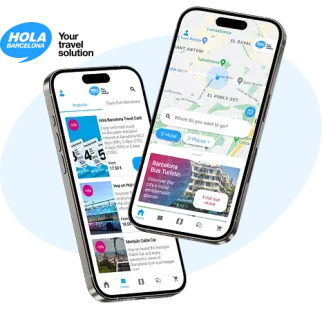El Poble-sec
From the most authentic neighborhood life to the Broadway of Barcelona
Poble Sec is a working-class and artisanal neighborhood, nestled between El Raval and Montjuïc, that has evolved into a lively district filled with entertainment venues, terraces, a diverse culinary and cultural scene, and a prime location. From here, it is easy to reach Barcelona's old town and the Montjuïc mountain.
Discover everything from small, traditional neighborhood bars to grand theaters showcasing the latest musical and theatrical productions.

Barcelona Bus Turístic, on the Hola Barcelona app
Your app for visiting the city with the Barcelona Bus Turístic: routes, stops and the most iconic places. A comfortable way to carry your tickets too!
Discover the most authentic neighborhood side of Barcelona without leaving the city center
Poble Sec is a Barcelona neighborhood that has preserved its distinct identity. Since its beginnings, it has traditionally been a popular working-class area, known for its vibrant and diverse cultural mix among residents. It is dynamic, rejuvenated, and increasingly bohemian.
Its proximity to El Raval and Montjuïc - home to landmarks such as the MNAC, the Fundació Joan Miró, and the Olympic Ring - makes Poble Sec an excellent starting point to explore Barcelona.
During the Middle Ages, Poble Sec was primarily an agricultural area. It was not until the second half of the 18th century that the neighborhood began to develop with the rise of manufacturing activities.
Due to its location outside the medieval walls and on the steep northern slope of Montjuïc, it was not included in Cerdà’s Eixample plan and thus remained outside the urban construction regulations of that plan. After the city walls were demolished, property owners began urbanizing the area by constructing modest homes for working-class and artisanal families, leading to the emergence of the Francia Xica, Santa Madrona, and Hortes de Sant Bertran districts.
Over the years, alongside industrial activity, the neighborhood became increasingly linked to the entertainment scene on Paral·lel, home to iconic theaters such as El Molino, Apolo, Condal, and Victòria—turning it into the epicenter of the city's nightlife, comparable to Montmartre or Broadway. Today, the cultural scene has spurred a new wave of leisure and gastronomy, transforming Poble Sec into a multicultural area. Its main thoroughfares include Carrer de Blai, which functions like a small rambla lined with bars and shops.
How to get to Poble Sec?
From the Miramar – Jardins Costa i Llobera stop on the Red Route of the Barcelona Tourist Bus, you can reach Poble Sec by walking down Passeig de Miramar and continuing along Carrer Nou de la Rambla. You can also access it from the Colom-Museu Marítim stop, which drops you at the entrance to Paral·lel.
For the curious ones
- The name "Poble Sec" originates from the mid-19th century, when the activity of factories in the area dried up the wells of the Hortes de Sant Bertran.
- On weekends, mid-morning vermouth on its terraces is practically a tradition.
- Joan Manuel Serrat was born in Poble Sec and is its most famous ambassador—he first performed at Plaça del Sortidor.










